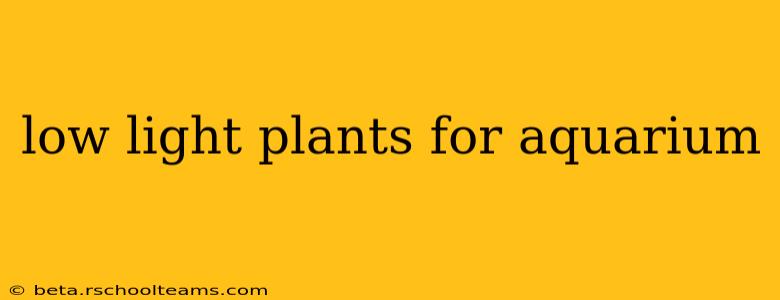Choosing the right plants for your aquarium can significantly impact its overall health and aesthetic appeal. While vibrant, high-light plants create stunning underwater landscapes, they demand intense lighting and meticulous care. For those with less-intense lighting or simply seeking low-maintenance options, low-light aquarium plants offer a fantastic alternative. This comprehensive guide explores the best low-light options, addressing common questions and providing essential care tips.
What are Low-Light Aquarium Plants?
Low-light aquarium plants are species that thrive even under moderate to low-intensity lighting conditions. Unlike their high-light counterparts, they don't require specialized lighting setups or frequent fertilization. This makes them ideal for beginners, busy individuals, or those with aquariums lacking powerful lighting systems. They are incredibly adaptable and tolerant of a wider range of water parameters, adding a touch of natural beauty without demanding excessive upkeep.
What are the Best Low-Light Aquarium Plants?
Several hardy and attractive plants flourish even under low light conditions. Some popular choices include:
-
Java Moss (Taxiphyllum barbieri): This versatile plant grows equally well attached to hardscape, rocks, driftwood, or allowed to float freely. It provides excellent hiding places for smaller fish and invertebrates and requires minimal care.
-
Anubias: Various Anubias species are highly adaptable and tolerate a wide range of water conditions. They grow slowly, making them perfect for low-maintenance setups. Avoid burying the rhizome (root-like structure) in the substrate; instead, attach it to rocks or wood.
-
Java Fern (Microsorum pteropus): Another extremely popular choice, the Java Fern is known for its resilience and ease of care. Similar to Anubias, attach it to hardscape rather than planting it in the substrate.
-
Amazon Sword (Echinodorus amazonicus): While technically a medium-light plant, the Amazon Sword can tolerate lower light conditions, albeit with slower growth. It's a classic choice, adding a stately presence to any aquarium.
-
Crypt (Cryptocoryne): Cryptocoryne species offer diverse leaf shapes and colors, providing aesthetic variety. They are relatively low-maintenance and adaptable to various lighting conditions.
How Much Light Do Low-Light Aquarium Plants Need?
The term "low light" is relative. While they don't need the intense illumination of high-light plants, low-light plants still require some light. Aim for 6-8 hours of indirect or low-intensity lighting per day. Avoid placing your tank in direct sunlight, as this can lead to algae blooms and harm your plants. A standard fluorescent or LED light fixture is typically sufficient.
What are the Benefits of Using Low-Light Aquarium Plants?
Beyond their low-maintenance nature, low-light plants offer several key benefits:
- Ease of Care: Perfect for beginners and busy schedules.
- Reduced Algae Growth: Low light conditions minimize the risk of algae outbreaks.
- Improved Water Quality: Plants naturally filter the water, removing waste products and improving overall water quality.
- Aesthetic Appeal: They enhance the aquarium's visual appeal, providing a natural and calming environment.
How Often Should I Fertilize Low-Light Aquarium Plants?
Low-light plants have lower nutrient requirements than their high-light counterparts. While you may not need to fertilize them regularly, a balanced liquid fertilizer can support their growth and enhance their color. Start with a diluted dose and observe your plants' response. Over-fertilizing can lead to algae growth.
What if My Low-Light Plants Aren't Growing?
Several factors can affect the growth of low-light plants. Consider these possibilities:
- Insufficient Light: While low light is sufficient, ensure your plants are receiving adequate illumination.
- Nutrient Deficiency: Introduce a balanced liquid fertilizer sparingly.
- Water Parameters: Check your water's pH, ammonia, nitrite, and nitrate levels.
- Poor Water Circulation: Ensure proper water flow throughout the tank.
Can I Use CO2 with Low-Light Aquarium Plants?
While not strictly necessary, adding CO2 can enhance the growth rate of even low-light plants. However, it's crucial to monitor CO2 levels carefully, as high concentrations can be harmful. Start slowly and monitor your plants closely.
By selecting the right low-light aquarium plants and providing adequate care, you can create a thriving and visually appealing underwater environment without the need for complex lighting setups and high-maintenance demands. Remember to research specific plant requirements and adapt your care routine accordingly. Enjoy the beauty and serenity of your low-light planted aquarium!
